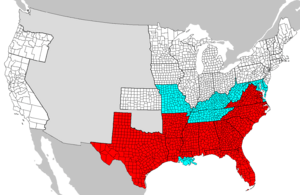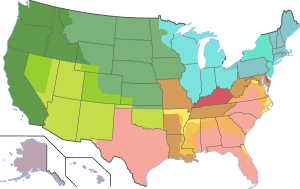Juneteenth facts for kids
Template:Infobox vevent Juneteenth (officially called Juneteenth National Independence Day) is a special holiday in the United States. It celebrates the day when the last enslaved people in the U.S. were finally told they were free. This happened on June 19, 1865, in Texas. The name "Juneteenth" is a mix of "June" and "nineteenth."
Even though President Abraham Lincoln had signed the Emancipation Proclamation in 1863, which said many enslaved people were free, it took time for the news to reach everyone. Texas was far away, and many slaveholders moved there with enslaved people to avoid the American Civil War. So, freedom didn't truly arrive for them until Union soldiers, led by Major General Gordon Granger, reached Galveston, Texas, on June 19, 1865. He announced that all enslaved people were now free.
Juneteenth started as a local celebration in Texas. Over time, it grew and spread across the country as African Americans moved to different states. It became a way to celebrate freedom, African-American culture, and the progress made since slavery ended. In 2021, Juneteenth became a federal holiday, meaning it's now recognized by the whole country.
Contents
Celebrating Juneteenth
Juneteenth is often called "America's second Independence Day." It's a day to celebrate, learn, and remember the journey to freedom. While it's officially on June 19, many celebrations happen on the third Saturday of June.
In the early days, celebrations included fun activities like baseball, fishing, and rodeos. Since African Americans often couldn't use public places due to unfair laws, they held their gatherings at churches or by water. These events featured big meals, and people wore their best clothes. Many formerly enslaved people even traveled back to Galveston to celebrate.
Today, Juneteenth is celebrated in many ways across the country. It's often a multicultural holiday, meaning people from all backgrounds join in. Some traditions include:
- Reading the Emancipation Proclamation aloud.
- Singing traditional songs like "Swing Low, Sweet Chariot" and "Lift Every Voice and Sing."
- Reading works by famous African-American writers.
Celebrations are full of joy and community spirit. You might see picnics, street fairs, cookouts, family reunions, and historical reenactments. There are often blues festivals and "Miss Juneteenth" contests. Red food and drinks are popular, like red velvet cake and strawberry soda. The color red represents strength and happiness.
Juneteenth events also focus on learning about African-American history and culture. Community leaders use the holiday to teach young people about their heritage and build pride. Many celebrations also include efforts to help people register to vote. It's also a time to enjoy soul food and other foods with African-American influences. Barbecue is a big part of many Juneteenth gatherings.
Some other countries also celebrate Emancipation Day, but on different dates. For example, people in Nacimiento, Mexico, have a festival called "el Día de los Negros" on June 19.
History of Freedom Day

On September 22, 1862, President Abraham Lincoln announced the Emancipation Proclamation. This important order said that enslaved people in the rebellious Southern states would be free starting January 1, 1863. However, this freedom could only be enforced when Union soldiers arrived in those areas.
Texas was the farthest state in the Confederacy. Many slaveholders moved there to avoid the fighting, bringing more enslaved people with them. By 1865, about 250,000 enslaved people were in Texas.
Even after Confederate General Robert E. Lee surrendered in April 1865, the war continued in some western areas. On June 19, 1865, Union Major General Gordon Granger arrived in Galveston, Texas, with over 2,000 federal troops. He announced General Order No. 3, which officially declared that all enslaved people in Texas were free.
This order said:
The people of Texas are informed that, in accordance with a proclamation from the Executive of the United States, all slaves are free. This involves an absolute equality of personal rights and rights of property between former masters and slaves, and the connection heretofore existing between them becomes that between employer and hired labor. The freedmen are advised to remain quietly at their present homes and work for wages. They are informed that they will not be allowed to collect at military posts and that they will not be supported in idleness either there or elsewhere.
While this day marked freedom for many, slavery didn't officially end everywhere in the U.S. until December 6, 1865. That's when the Thirteenth Amendment to the U.S. Constitution was approved, making slavery illegal across the entire country.
Early Juneteenth Celebrations
After General Order No. 3 was announced, formerly enslaved people in Galveston celebrated with great joy. One year later, on June 19, 1866, they organized the first "Jubilee Day" celebrations. These early events were also used as political gatherings to teach newly freed African Americans about their voting rights.
Because of segregation (laws that kept Black and white people separate), Black people often couldn't use public parks. So, they sometimes bought their own land for celebrations. For example, in 1872, Black leaders in Texas raised money to buy 10 acres of land in Houston, now known as Emancipation Park, specifically for Juneteenth celebrations.
The celebrations grew, attracting thousands of people across Texas. By the 1890s, people started calling Jubilee Day "Juneteenth."
Challenges and Revival
In the early 1900s, Juneteenth celebrations became less common. This was partly due to unfair Jim Crow laws that took away rights from Black people. Also, many African Americans moved to cities or to the North during the Great Migration to find work, and it was harder to take time off for the holiday. Some younger generations also focused on fitting into mainstream culture.
However, Juneteenth began to revive in the 1970s. The Civil Rights Movement of the 1950s and 1960s, which fought for equal rights, reminded people of the importance of celebrating freedom. In 1968, during the Poor People's Campaign in Washington, D.C., June 19 was made "Solidarity Day."
In 1979, Al Edwards, a state representative from Houston, helped make Juneteenth a paid state holiday in Texas. This was a big step! He also started an annual prayer breakfast and celebration at Ashton Villa, a historic home in Galveston, where a historian reads General Order No. 3.
Growing Recognition
Since the 1980s, Juneteenth has become more widely celebrated. Museums have held exhibitions, and communities across the U.S. and even in other countries have organized events. In 1999, a famous novel called Juneteenth by Ralph Ellison was published, helping more people learn about the holiday.
In 1997, activist Ben Haith created the Juneteenth flag. The flag has a star in the middle, representing Texas and freedom for all African Americans. The burst around the star looks like a new star, and the red curve is like a new horizon, showing a new era. The red, white, and blue colors are like the American flag, reminding everyone that African Americans are a part of the nation's story of liberty and justice.
In recent years, Juneteenth has gained even more attention. TV shows like Atlanta and Black-ish have featured the holiday. Many companies and universities now recognize Juneteenth, giving employees a paid day off or holding special events.
Becoming a Federal Holiday
For many years, activists and lawmakers worked hard to make Juneteenth a national holiday. A dedicated activist named Opal Lee, often called the "grandmother of Juneteenth," walked for miles to raise awareness.
Finally, on June 15, 2021, the Senate voted to make Juneteenth a federal holiday. The next day, the House of Representatives also approved it. On June 17, 2021, President Joe Biden signed the bill into law. This made Juneteenth the eleventh federal holiday in the U.S. and the first new one since Martin Luther King Jr. Day was created in 1983. Now, federal government employees get the day off every year on June 19.
Official Recognition
Texas was the first state to make Juneteenth an official state holiday in 1980. Over the years, more and more states recognized the day. By 2019, 47 states and the District of Columbia recognized Juneteenth in some way.
After the federal holiday was created in 2021, many more states and cities also made Juneteenth a paid holiday for their workers. As of 2024, 27 states and the District of Columbia have made Juneteenth a paid holiday for state employees. This shows how important Juneteenth has become across the entire United States.
Images for kids
-
Major General Gordon Granger issued General Order No. 3 formally informing Texas residents that slavery had ended.
-
General Order No. 3, June 19, 1865
-
Emancipation Day celebration in Richmond, Virginia, 1905
-
Flyer for a 1980 Juneteenth celebration at the Seattle Center
See also
 In Spanish: Juneteenth para niños
In Spanish: Juneteenth para niños
- History of African Americans in Texas
- Independence Day (United States)
- List of African-American holidays
- Negro Election Day
- Public holidays in the United States











